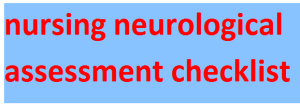nursing neurological assessment checklist 2024-2025
nursing neurological assessment checklist 2024-2025

CHECKLIST FOR NEUROLOGICAL ASSESSMENT
During the initial nurse-patient interaction, begin evaluating a patient’s general appearance, posture, walking ability, personal hygiene, and other general survey assessments. It’s helpful to show the patient how to move when you ask them to do specific neurological tests. Describe the equipment’s function and use.
Review the steps necessary to finish a routine “Neurological Assessment” by using the checklist below.
Steps
Disclaimer: Always review and follow agency policy regarding this specific skill.
- Collect supplies: penlight. Additional supplies may be required for a comprehensive neurological examination: Chart by Snellen; a tongue-depressor; cotton applicator or wisp; percussion hammer, and things that can be touched, like paper clips or coins; substances that smell, like coffee, vanilla, or mint; as well as flavors like lemon, salt, and sugar.
- Perform safety steps:
- Keep your hands clean.
Verify any transmission-related safety measures in the space.
Introduce yourself, your position, the reason for your visit, and a rough time estimate.
Use two patient identifiers to verify the patient’s identity (e.g., name and date of birth).
Ask the patient if they have any questions after outlining the procedure.
Be methodical and organized.
Utilize effective listening and questioning techniques.
patient cues, and pay attention to them.
Respect the patient’s dignity and privacy.
Evaluate ABCs. - Utilizing excellent communication, gather subjective evaluation information about any current neurological issues and any history of neurological disease.
During the interview, evaluate the patient’s demeanor, language, attitude, hygiene, and attire. Note any hearing or vision issues, and make sure any necessary glasses or hearing aids are in place.
Use the Glasgow Coma Scale to determine the patient’s state of consciousness and orientation.
(Optional) If necessary, finish the Mini-Mental State Examination (MMSE). - Assess for PERRLA.
- Assess motor strength and sensation.
- Hand grasps
- Upper body strength/resistance
- Lower body strength/resistance
- Sensation in extremities
- Assess coordination and balance.
- Assess the patient’s smoothness, coordination, and arm swing by asking the patient to walk with an assistive device if necessary.
Assess the patient’s ability to walk on tiptoes, in heels, or in tandem (heel to toe).
Utilize Romberg, pronator drift, rapid alternating hand movement, fingertip-to-nose, and heel-to-shin tests to evaluate cerebellar functioning.
- Assess deep tendon reflexes and the cranial nerve as indicated (optional).
- Assist the patient in a comfortable position, inquire about their concerns, and express gratitude for their time.
- When you leave the room, follow these five safety precautions:
- CALL LIGHT: Within reach
- BED: Low and locked (in lowest position and brakes on)
- SIDE RAILS: Secured
- TABLE: Within reach
- ROOM: Risk-free for falls (scan the room and clear any obstacles)
- Perform hand hygiene.
- In accordance with agency policy, document the assessment’s findings and report any concerns.
Click here for South African Nursing Colleges and Schools Application 2023-2024
RELATED LINKS
Nursing Online Application links